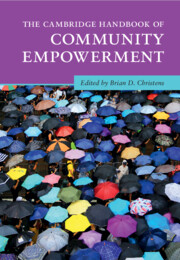Book contents
- The Cambridge Handbook of Community Empowerment
- Cambridge Handbooks in Psychology
- The Cambridge Handbook of Community Empowerment
- Copyright page
- Contents
- Figures
- Tables
- Contributors
- Building Community Power
- Part I Organizing and Activism
- 1 Youth Organizing
- 2 Youth Activism in Postapartheid South Africa
- 3 Domestic Violence and Community Organizing in India
- 4 Congregation-Based Community Organizing
- 5 Immigrant Organizing and Activism
- 6 Online Racial Justice Advocacy
- Part II Participatory Governance
- Part III Civil Society and Coalitions
- Part IV Enterprise
- Part V Participatory and Community Arts
- Part VI Education and Engaged Research
- Contributor Details
- Index
- References
3 - Domestic Violence and Community Organizing in India
from Part I - Organizing and Activism
Published online by Cambridge University Press: 18 April 2024
- The Cambridge Handbook of Community Empowerment
- Cambridge Handbooks in Psychology
- The Cambridge Handbook of Community Empowerment
- Copyright page
- Contents
- Figures
- Tables
- Contributors
- Building Community Power
- Part I Organizing and Activism
- 1 Youth Organizing
- 2 Youth Activism in Postapartheid South Africa
- 3 Domestic Violence and Community Organizing in India
- 4 Congregation-Based Community Organizing
- 5 Immigrant Organizing and Activism
- 6 Online Racial Justice Advocacy
- Part II Participatory Governance
- Part III Civil Society and Coalitions
- Part IV Enterprise
- Part V Participatory and Community Arts
- Part VI Education and Engaged Research
- Contributor Details
- Index
- References
Summary
Efforts to respond to women’s risk of domestic violence in India have resulted in two kinds of systemic responses. First, the formal or institutional response has focused on systems reforms to better meet the needs of survivors. Second, nongovernmental and grassroots responses to domestic violence have emphasized supporting survivors through survivor-centered and empowerment-based approaches. These include primary prevention through community activism aimed at transforming community norms, survivor empowerment, capacity-building, and community mobilization. This chapter describes an exemplary effort by “Shakti” (pseudonym), a grassroots agency based in India, to engage in community mobilization that facilitates psychological empowerment of survivors and community empowerment processes to respond to domestic violence in rural communities in the Delhi National Capital Region, India. The case example draws on data collected by the authors in 2017. Community organizing efforts like those described in this chapter along with individual-level work with survivors can together play an important role in fueling counter-narratives that facilitate disclosure of violence and support survivors.
Keywords
- Type
- Chapter
- Information
- The Cambridge Handbook of Community Empowerment , pp. 83 - 109Publisher: Cambridge University PressPrint publication year: 2024



